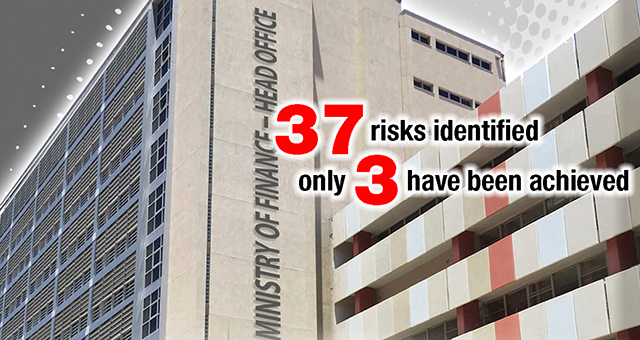By SHINOVENE IMMANUEL and LAZARUS AMUKESHE | 07 December 2018
In a draft report titled Fiscal Risk Statement dated 23 November 2018, the IMF warned that Namibia risks remaining at non-investment status [junk status], meaning the country would have to pay more for loans.
A fiscal risk statement helps policymakers to understand the country’s financial position, and what measures should be taken to fix the economy.
The government asked the IMF to assess Namibia’s fiscal position as the country has struggled to escape recession since 2016, and its debt has grown to levels that many believe is only a matter of time before lenders begin to determine national policies.
Finance minister Calle Schlettwein confirmed to The Namibian yesterday that they had worked with the IMF on this report.
“The outcome of that cooperation is the report which formed the basis for our budget formulation for the coming MTEF [Medium-Term Expenditure Framework] and beyond,” he said. MTEF is the government’s spending plans over three years. The IMF report lists four major risks — state-owned enterprises, municipalities, the dependency on the South African economy, and the lack of economic reforms — in need of urgent attention.
Public debt has almost doubled from 30% of gross domestic product in 2015/16 to the current 50% during the last three years, while the economy is unlikely to grow strong enough in the long-term.
With major loan repayment expected with the first Eurobond in 2021, the report said Namibia might have to pay 3% of GDP more in the cost of borrowing from 15% for the next two years.
The strong correlation between the two countries’ economies and the lower than expected growth in South Africa can also adversely impact Namibia’s economy.
‘PARASITICAL’ PARASTATALS
Previously underrated, a key concern over unsustainable debt is the uncertainty of whether parastatals will repay their debts, for which government is the guarantor. Namibia has up to 18 profit-driven parastatals.
These commercial state-owned entities, according to public enterprises minister Leon Jooste, have a N$62 billion asset value, N$30 billion liabilities, and annual income of N$23 billion.
The government makes a profit of N$1,9 billion, which gives the state a return on investment of only around 1,2% a year.
“Poorer-than-anticipated financial performance, liquidity pressures or a weakening in the financial position of public entities could result in lower dividends and taxes being received,” the IMF said, adding that this will increase the need for funding through subsidies or government guarantees.
According to the fund, there are nine high-risk entities in Namibia which hold the bulk of liabilities, and receive different forms of direct and indirect state support.
These entities are the Namibia Power Corporation, the Development Bank of Namibia, Namibia Post, the Namibia Ports Authority, the University of Namibia, Namibia Water Corporation, Telecom Namibia, TransNamib Holdings and Air Namibia.
Four of these entities made losses in 2017, the report said. In addition, municipalities have a fiscal impact of about N$500 million.
The report said state-owned enterprises Air Namibia and Namport alone would cost the country about N$4,8 billion. There is no plan to address this, the bank said.
There are mitigating plans in place for the state-owned financial institutions in terms of on-lending defaults and called guarantees.
NO PLAN
The government has said it has a plan to save the failing Namibian economy. However, the IMF report paints a picture of failure to plan.
The report includes a table that shows that Namibia’s economy is faced with 37 risks. Of the 37 risks, only three have mitigation plans. NamPower is the only state-owned enterprise with a plan to handle its debt.
The IMF also warns that public sector salaries and the medical schemes cannot be sustained in their current form. It calls for changes, such as charging employees more personal contributions.
The bulk of the government’s money is allocated to personnel expenditures, with a reported N$28 billion spent last year – out of the N$62,5 billion national budget – on approximately 119 000 civil servants’ salaries and benefits.
WAY FORWARD
The IMF has drafted about 35 recommendations, all with deadlines set for 2019. The government is expected to recruit additional advisers who will help formulate debt and government wage bill management strategies.
The IMF also recommended that new boards for the major state enterprises should be appointed, who should be tasked to develop business plans, and ensure that approved investment projects will have guaranteed funding.
PSG Namibia analyst and equity strategist Eloise du Plessis told The Namibian yesterday that there is no mitigation plan in place for all the identified macroeconomic risks.
“The options for mitigation indicated are to improve macro-fiscal forecasting by recruiting new staff in the economic policy advisory services; reduce the expenditure rigidities by formulating a strategy for managing the wage bill; and strengthening debt management,” she said.
Du Plessis also confirmed that poor planning had been one of the major sources of problems that caused cost overruns and cash depletion.
Besides, ministers who enter into agreements before getting approval from the finance ministry were also a source of significant risk and concern, she added.
“There needs to be clear policy reform regarding how the government manages on a day-to-day basis. Better planning, sticking to guidelines for large investment projects, and more reliable economic forecasting are broadly the areas where we need to see improvement,” Du Plessis said.






